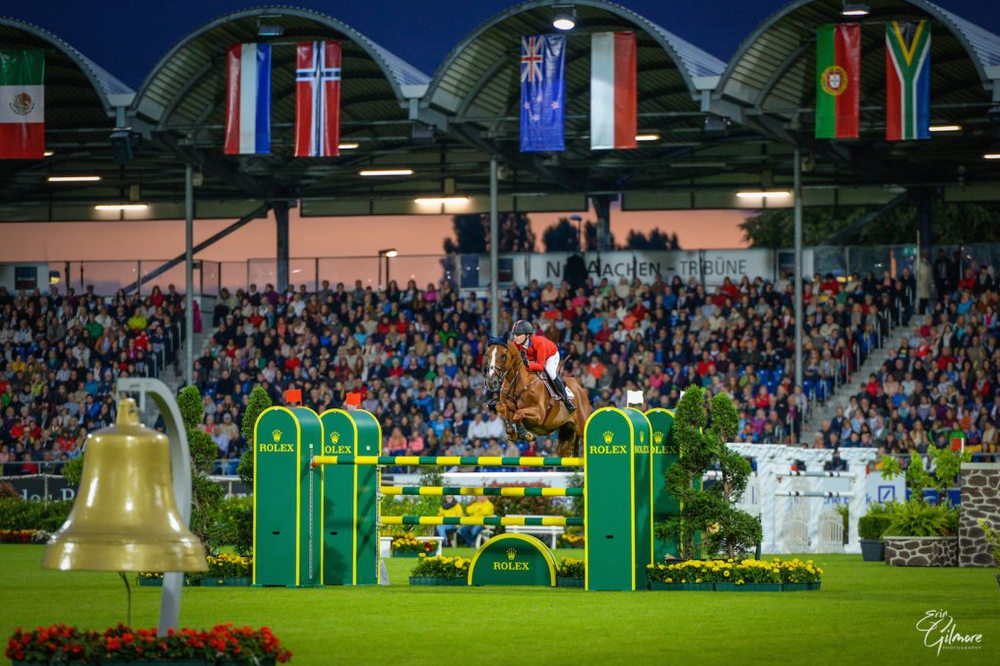The Nations Cup Series: Thriving or Just Surviving?

Ask any Irish rider or fan what the most exciting moment in show jumping was in 2019, and they will now say without hesitation: the Longines FEI Nations Cup Final.
Long held up as the most prestigious team achievement outside of the Olympics, the Nations Cup Final on Oct. 6 in Barcelona, Spain, did not disappoint. From the super tough 1.60m course, to a shocking twist during the last round of the class, and an incredible win for Ireland, it was a banner weekend for show jumping. Ireland had never before been victorious in the Nations Cup Final, and elation was especially through the roof because this was Ireland’s last chance to qualify a team for the 2020 Tokyo Olympics, something that has eluded Irish riders for the past 16 years.
So in the wake of all that, why then, is the Nations Cup series said to be. . . . struggling?
It was Irish rider Shane Sweetnam who spoke up over the summer at the International Jumping Riders Club General Assembly to voice rider frustrations (Shane was not on the Irish team in Barcelona, but is a respected veteran of that and many other Nations Cup competitions.) Shane pointed out that the standard of the Nations Cups has dropped in the last two-to-three years — that the level has been dumbed down. One reason is that the FEI is trying to increase its base by inviting riders from less experienced nations.
“I feel we are getting a little bit lost at the moment,” Shane said. “I know you want more countries in it, but when the lesser countries do come into these leagues, they do struggle every time. It’s at a difficult period, in my opinion.”
Longines vs. Nations Cup
Another elephant in the room here is that riders now have other, more lucrative choices pulling them away from representing their country in a Nations Cup. That elephant is called the Longines Global Champions Tour/League and not even the IJRC wants to name it directly. But when they say that “the approval of new series, composed of up to sometimes 20 events, risks creating a monopoly. . .” yeah, there is only one elephant that fits that definition.
It’s a pickle for the FEI, which approved the LGCT’s expansion and threw its support behind the Global Champions League in 2017. Now that same series is a problem for its most important product – the Nations Cup. It’s harder for top riders to justify representing their country in a Nations Cup on the same weekend that they could be competing in a many times more lucrative LGCT class. Fewer top riders entered lowers the level of the competition. The FEI promised some solutions after a jumping committee meeting that was to take place last weekend at Barcelona. I am on the edge of my seat for that press release.
Based on my own personal experience attending and reporting on Nations Cups around the world, I do agree with Shane about the dumbing down factor – depending on which Nations Cup event he’s looking at.
Let’s review.
A few years ago, the FEI streamlined its Longines FEI Nations Cup Series, breaking the globe up into seven geographic regions and two divisions. Division One (some still call it the Super League) includes the top-tier nations, Division Two is made up of the others, about 42 nations total that winnow down to 18 who qualify for the yearly Final. At the same time, the FEI shaved down its event schedule, resulting in fewer overall events that were meant to enhance the focus on the remaining ones. Sponsorship conflicts (here’s looking at you, Longines and Rolex) caused two of the world’s very best Nations Cup stages, at Aachen, Germany, and Spruce Meadows, Canada, to drop out of the series. Those Nations Cups are still held as standalone events, but they do not count for series points and are not part of the Longines FEI Nations Cup Series.

This is ironic because there is no better example of top-level Nations Cup show jumping as a mainstream sport than the Nations Cup classes at Aachen and Spruce Meadows. Compared to the Nations Cups held elsewhere . . . well, there is no comparison. As Shane is based in North America and spends the majority of his time here, I’m going to go out on a limb and say that he could possibly be referring to the Nations Cup that is still held during the winter circuit at WEF in Wellington, Fla., as one that is “dumbed down”.
“It’s harder for top riders to justify representing their country in a Nations Cup on the same weekend that they could be competing in a many times more lucrative LGCT class.”
It’s not WEF’s fault, not really, that the Nations Cup during week eight of circuit feels too long and too boring to those in the crowd that stick around to watch it. For the last five years, it has not counted towards the Longines FEI series (again, Rolex. . .) The Florida spectators who are used to the energy of a 35-round grand prix with jump off under the lights never seem to understand the double rounds and team rotation of Nations Cup night. Seats sit empty. The announcer drolly recites which rider is up next. I stood ringside during this class in Wellington for many years, but I never truly understood what it was lacking until I went to the Aachen Nations Cup for the first time in 2016 and had an “aha!” moment.
Where To Go From Here?
You can feel the electricity of 40,000 people packed in under the lights at Aachen. The size of the place contributes to the epic sport, which is supremely difficult and attracts the best riders in the world. I don’t speak German so I don’t know what the announcer is saying, but it’s enough to keep butts in seats as the action ramps up. Feeling the place reverberate as a German rider canters in through the in-gate is enough to give you chills. Chills. It is nothing like a Nations Cup in America. It is nothing like any show jumping class in America. It is nothing like anything I’ve ever seen.
And it’s really not fair to compare Aachen to the Nations Cup at WEF, or in Mexico, or anywhere else around the world. I’ve often wondered if the FEI regrets dropping Aachen and Spruce Meadows from its series lineup, if that is even partly to blame for the “dumbing down” of the series.
The Global Champions Tour has made a product of over-declaring each stage of their 22-week tour an absolutely epic moment in sport. But sports don’t work like that. Every class is not epic. Every win is not a game changer. If anything, the Nations Cup series is a kind of victim of growth, and its challenges are a direct result of more show choices and prize money chances than ever, combined with the necessary growth of the sport to include more flags. If we want to see top sport weekends like Barcelona continue for many more years to come, it is, as always, up to the FEI to streamline the sport once again, and boost its banner product up to “epic” status again.


